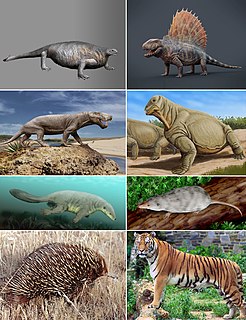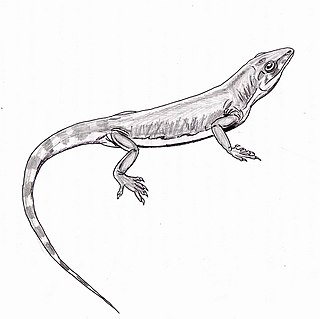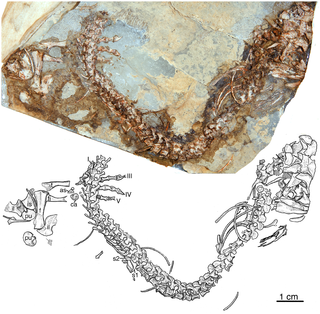
Synapsids are one of the two major groups of animals that evolved from basal amniotes, the other being the sauropsids, the group that includes reptiles and birds. The group includes mammals and every animal more closely related to mammals than to sauropsids. Unlike other amniotes, synapsids have a temporal fenestra, an opening low in the skull roof behind each eye orbit, leaving a bony arch beneath each; this accounts for their name. The distinctive temporal fenestra developed about 318 million years ago during the Late Carboniferous period, when synapsids and sauropsids diverged, but was subsequently merged with the orbit in early mammals.

Sauropsida is a clade of amniotes, broadly equivalent to the class Reptilia. Sauropsida is the sister taxon to Synapsida, the clade of amniotes which includes mammals as its only modern representatives. Although early synapsids have historically been referred to as "mammal-like reptiles", all synapsids are more closely related to mammals than to any modern reptile. Sauropsids, on the other hand, include all amniotes more closely related to modern reptiles than to mammals. This includes Aves (birds), which are now recognized as a subgroup of archosaurian reptiles despite originally being named as a separate class in Linnaean taxonomy.

Dimetrodon ( or, meaning "two measures of teeth,” is an extinct genus of non-mammalian synapsid that lived during the Cisuralian, around 295–272 million years ago. It is a member of the family Sphenacodontidae. The most prominent feature of Dimetrodon is the large neural spine sail on its back formed by elongated spines extending from the vertebrae. It walked on four legs and had a tall, curved skull with large teeth of different sizes set along the jaws. Most fossils have been found in the Southwestern United States, the majority coming from a geological deposit called the Red Beds of Texas and Oklahoma. More recently, fossils have been found in Germany. Over a dozen species have been named since the genus was first erected in 1878.

Pelycosaur is an older term for basal or primitive Late Paleozoic synapsids, excluding the therapsids and their descendants. Previously, the term mammal-like reptile had been used, and pelycosaur was considered an order, but this was discovered to be incorrect and is now seen as outdated.

Sphenacodontia is a stem-based clade of derived synapsids. It was defined by Amson and Laurin (2011) as "the largest clade that includes Haptodus baylei, Haptodus garnettensis and Sphenacodon ferox, but not Edaphosaurus pogonias". They first appear during the Late Pennsylvanian epoch. From the end of the Carboniferous to the end of the Permian, most of them remained large, with only some secondarily becoming small in size.

Caseasauria is one of the two main clades of early synapsids, the other being the Eupelycosauria. Caseasaurs are currently known only from the Late Carboniferous and the Permian, and include two superficially different families, the small insectivorous or carnivorous Eothyrididae, and the large, herbivorous Caseidae. These two groups share a number of specialised features associated with the morphology of the snout and external naris.

Varanopidae is an extinct family of amniotes that resembled monitor lizards and may have filled a similar niche, hence the name. Typically, they are considered synapsids that evolved from an Archaeothyris-like synapsid in the Late Carboniferous. However, some recent studies have recovered them being taxonomically closer to diapsid reptiles. A varanopid from the latest Middle Permian Pristerognathus Assemblage Zone is the youngest known varanopid and the last member of the "pelycosaur" group of synapsids.

Sphenacodontoidea is a node-based clade that is defined to include the most recent common ancestor of Sphenacodontidae and Therapsida and its descendants. Sphenacodontoids are characterised by a number of synapomorphies concerning proportions of the bones of the skull and the teeth.

Tetraceratops insignis is an extinct synapsid from the Early Permian that was formerly considered the earliest known representative of Therapsida, a group that includes mammals and their close extinct relatives. It is known from a single 90-millimetre-long (3.5 in) skull, discovered in Texas in 1908. According to a 2020 study, it should be classified as a primitive non-therapsid sphenacodont rather than a genuine basal therapsid.
Driveria is an extinct genus of non-mammalian synapsids the Lower Permian of San Angelo Formation, Texas.
Emyduranus is an extinct genus of non-mammalian synapsid from the Permian Cistecephalus Assemblage Zone and the Teekloof Formation of the Beaufort Group, South Africa.
Elliotsmithia is a small varanopid synapsid found from the late Middle Permian of South Africa. It is the sole basal synapsid "pelycosaur" known from the supercontinent Gondwana and only two specimens have been yielded to date. Its species name longiceps is derived from Latin, meaning "long head". Both known Elliotsmithia fossils were recovered from Abrahamskraal Formation rocks—within the boundaries of the Tapinocephalus Assemblage Zone—of the lower Beaufort Group.
Knoxosaurus is an extinct genus of non-mammalian synapsids containing the species Knoxosaurus niteckii that existed approximately 279.5 to 268 million years ago. It was named by American paleontologist Everett C. Olson in 1962 on the basis of fragmentary fossils from Middle Permian-age deposits in the San Angelo Formation of Texas in the United States. Olson placed Knoxosaurus in a new infraorder called Eotheriodontia, which he considered a transitional group between the more reptile-like "pelycosaurs" and the more mammal-like therapsids. Knoxosaurus and Olson's other eotheriodonts were later considered to be undiagnostic remains of basal synapsids, no more closely related to therapsids than are other pelycosaur-grade synapsids.
Lanthanostegus is an extinct genus of non-mammalian synapsids from the Capitanian Tapinocephalus Assemblage Zone, Koonap Formation of South Africa.
Trichasaurus is an extinct genus of caseid synapsids.

Smilesaurus is an extinct genus of gorgonopsian known from Africa. It lived during the Late Permian. It contains the single species S. ferox.
Watongia is an extinct genus of non-mammalian synapsids from Middle Permian of Oklahoma. Only one species has been described, Watongia meieri, from the Chickasha Formation. It was assigned to family Gorgonopsidae by Olson and to Eotitanosuchia by Carroll. Reisz and collaborators assigned the genus in Varanopidae.
Uralokannemeyeria is an extinct genus of non-mammalian synapsid.

Eocasea is an extinct genus of caseid synapsids from the Late Pennsylvanian of Kansas. It is known from a single type species, Eocasea martini.
Ascendonanus is an extinct genus of varanopid amniote from the Early Permian of Germany. It is one of the earliest specialized arboreal (tree-living) tetrapods currently known and outwardly resembled a small lizard. The animal was about 40 cm long, with strongly curved claws, short limbs, a slender, elongated trunk, and a long tail. It would have preyed on insects and other small arthropods.














